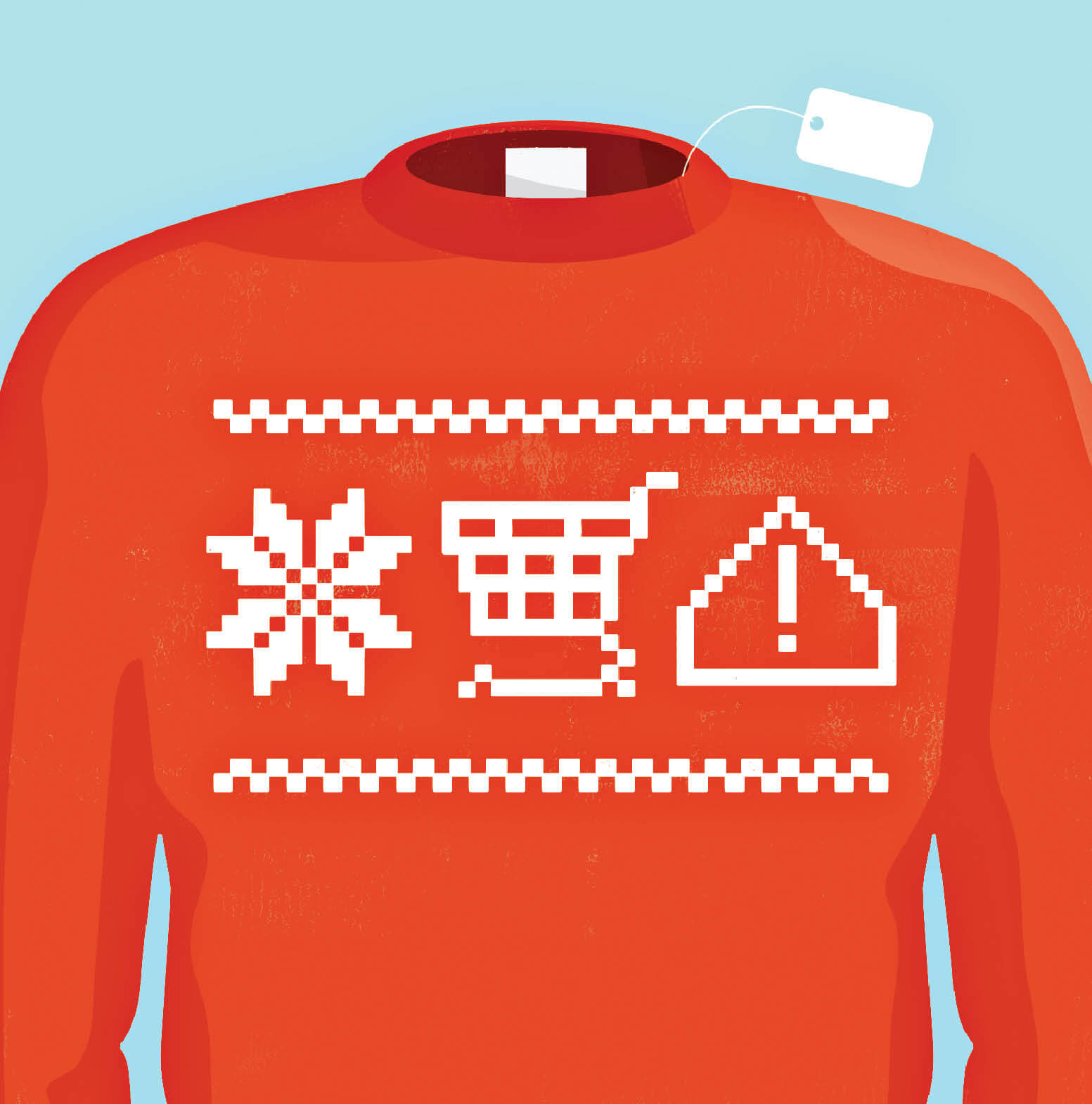Your Money: Fraud Watch
ONLINE SHOPPING’S HOLIDAY HORRORS
Counterfeit products and fake online stores can steal your money and identity

Afloral-print scarf reminds Debra Berlyn that even an internet advocate can fall for an online shopping scam. “I saw a social media ad for a scarf that doubled as a COVID mask,” says Berlyn, of Washington, D.C., executive director of the Project to Get Older Adults onLine (Project GOAL). “But it was flimsy, tiny and didn’t serve its purpose. It taught me the lesson to always double-check before I purchase something via social media.”
Online shopping scams are big business—especially around the holidays, says Amy Nofziger, director of victim support for the AARP Fraud Watch Network.
Nearly 3 out of 4 Americans ages 18 to 85 told a 2023 Michigan State University survey they’d bought a fake product in the previous year. Scammers “are using very sophisticated strategies,” says survey coauthor Saleem Alhabash. “You have to be critical of every product you buy online.”
Here are things to watch out for to avoid online shopping scams, and some new twists crooks are employing this holiday season.
▶︎ Look-alike products: Americans buy $2 trillion in counterfeit products annually, says the National Crime Prevention Council (NCPC). These include knockoffs of brand-name shoes and clothes, household goods, toys, sports equipment, cosmetics and more.
The twist: Fake products online are more convincing than ever. Counterfeiters use artificial intelligence to modify product information to deceive consumers into thinking their products are authentic, Alhabash says. They also use photos of legitimate products, says Kimberly Gianopoulos, managing director of international affairs and trade for the U.S. Government Accountability Office. Her team bought fake products and found “it’s really hard to tell if something is counterfeit or not.” One fake travel mug looked like the real thing—except for a tiny “made in” stamp on the bottom that misspelled the manufacturer’s location.
▶︎ Faked safety seals on counterfeit electronics: One in 10 digital devices—cellphones, TVs, computers, gaming systems, music players and more—sold around the world may be fake, according to research cited by Havocscope, a company that monitors the global black market. There’s danger: Counterfeit devices and accessories cause more than 70 deaths and 350,000 injuries a year in the U.S., the NCPC says.
The twist: Scammers fake safety certifications on counterfeit electronics, says Robert Slone, senior vice president and chief scientist at UL Solutions, a private company that certifies electronics and other products. “There are significant risks possible with counterfeit products,” he says. “We’ve strengthened the UL Mark by adding holographic labels on some products to make them harder to replicate.”
▶︎ Phony websites and fake stores in online marketplaces: Scammers set up impostor websites that look like those of famous brands and well-known retailers, Nofziger says. Fake shops almost never deliver the products they advertise. You might get a false item, but in most cases, criminals steal your money and your financial information.
The twist: Scammers also act like third-party sellers on big online marketplaces such as Walmart.com and Amazon.com, creating “pop-up” fake stores that offer goods at rock-bottom prices, grab your cash or credit card information, then vanish in a matter of hours. Fake e-commerce stores have fooled more than 850,000 U.S. and European consumers, stealing $50 million from them since 2021, according to “BogusBazaar,” a May 2024 report from the German cybersecurity group Security Research Labs.
Smart Ways to Shop Safely Online
Steer clear of deep discounts and “sale ends soon” urgency. Emails, texts and social media messages advertising unusually large price cuts can be a tip-off that an item is counterfeit, Nofziger says.
▶︎ Don’t rely completely on price—or customer ratings. Some scammers charge full price for fakes to deceive buyers, and manage to accrue—or fake—positive customer ratings, Gianopoulos says.
▶︎ Don’t click on links in online solicitations. Look up seller websites online, or use the URL on a bill or store credit card. Then make sure that the brand name is spelled correctly in the URL and that there’s a lock icon before it, indicating the site is secure for credit card transactions.
▶︎ Check for customer service contact information and a place to click for returns, Alhabash recommends. Search the name of an unfamiliar third-party seller online with the word “scam” or “complaint” or “review” to check for problems.
▶︎ Double-check safety seals. Look up a certification company’s safety seal on a product before you buy it to make sure it’s genuine, Slone recommends.
▶︎ Buy with a credit card. Don’t purchase from sellers who want payment by gift card, peer-to-peer apps or cryptocurrency.
Sari Harrar is a contributing editor for AARP and frequently writes on health and fraud for the Bulletin.
Have questions related to scams? Call the AARP Fraud Watch Network helpline toll-free at 877-908-3360. For the latest fraud news and advice, go to aarp.org/fraudwatchnetwork.